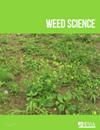Effect of Degree of Water Stress on Growth and Fecundity of Velvetleaf (Abutilon theophrasti) Using Soil Moisture Sensors
IF 2.1
2区 农林科学
Q2 AGRONOMY
引用次数: 0
Abstract
Abstract Velvetleaf (Abutilon theophrasti Medik.) is a troublesome broadleaf weed that competes with crops for resources such as soil moisture. Water stress can affect the ability of weed species to grow and produce seeds. The objective of this study was to determine the effect of degree of water stress on the growth and fecundity of A. threophrasti using soil moisture sensors under greenhouse conditions. Abutilon threophrasti seeds collected from a corn (Zea mays L.)–soybean [Glycine max (L.) Merr.] field were grown in silty clay loam soil, and plants were maintained at 100%, 75%, 50%, and 25% soil field capacity (FC) corresponding to no, light, moderate, and high water-stress conditions, respectively. Water was added daily to pots based on soil moisture levels detected by a Meter Group 5TM sensor to maintain the desired water-stress level required by treatment. Plants maintained at 100% FC had the maximum number of leaves (28 leaves plant–1), followed by 21 and 15 leaves plant–1 at 75% and 50% FC, respectively. Abutilon threophrasti at 100% and 75% FC achieved maximum plant height (108 to 123 cm) compared with 83 cm at 50% FC. Abutilon threophrasti maintained at 75% FC had the greatest growth index (79,907 cm3) followed by 72,197 cm3 at 100% FC and 64,256 cm3 at 50% FC. Seed production was similar at 100%, 75%, and 50% FC (288 to 453 seeds plant–1) compared with 2 seeds plant–1 at 25% FC. This is because the majority of plants maintained at 25% FC did not survive more than 77 d after transplanting. Seed germination was 96% to 100% at 100%, 75%, and 50% FC compared with 20% germination at 25% FC. Abutilon threophrasti can survive ≥50% FC continuous water-stress conditions, although with reduced leaf number, plant height, and growth index compared with 75% and 100% FC.水分胁迫程度对棉叶生长和繁殖力的影响
摘要Velvetleaf(Abutilon theoprasti Medik.)是一种麻烦的阔叶杂草,它与作物争夺土壤水分等资源。水分胁迫会影响杂草的生长和产生种子的能力。本研究的目的是在温室条件下使用土壤湿度传感器来确定水分胁迫程度对苏铁藻生长和繁殖力的影响。从玉米(Zea mays L.)-大豆[Glycine max(L.)Merr.]田地中采集的苏铁种子生长在粉质粘壤土中,植物分别保持在100%、75%、50%和25%的土壤田间容量(FC),对应于无、轻度、中度和高水分胁迫条件。根据Meter Group 5TM传感器检测到的土壤湿度水平,每天向花盆中加水,以保持处理所需的水胁迫水平。维持在100%FC的植物具有最大的叶片数量(28叶植物-1),其次是21叶和15叶植物-1,分别为75%和50%FC。在100%和75%的FC条件下,苏铁获得了最大株高(108至123厘米),而在50%的FC条件中为83厘米。维持在75%FC下的苏铁具有最大的生长指数(79907 cm3),其次是100%FC下的72197 cm3和50%FC下的64256 cm3。种子产量在100%、75%和50%FC时相似(288至453粒种子植物-1),而在25%FC时为2粒种子植物-1。这是因为大多数维持在25%FC的植物在移植后存活时间不超过77天。在100%、75%和50%FC条件下,种子发芽率为96%至100%,而在25%FC条件下发芽率为20%。尽管与75%和100%FC相比,苏铁的叶片数、株高和生长指数有所降低,但苏铁能在≥50%FC的连续水分胁迫条件下存活。
本文章由计算机程序翻译,如有差异,请以英文原文为准。
求助全文
约1分钟内获得全文
求助全文
来源期刊

Weed Science
农林科学-农艺学
CiteScore
4.60
自引率
12.00%
发文量
64
审稿时长
12-24 weeks
期刊介绍:
Weed Science publishes original research and scholarship in the form of peer-reviewed articles focused on fundamental research directly related to all aspects of weed science in agricultural systems. Topics for Weed Science include:
- the biology and ecology of weeds in agricultural, forestry, aquatic, turf, recreational, rights-of-way and other settings, genetics of weeds
- herbicide resistance, chemistry, biochemistry, physiology and molecular action of herbicides and plant growth regulators used to manage undesirable vegetation
- ecology of cropping and other agricultural systems as they relate to weed management
- biological and ecological aspects of weed control tools including biological agents, and herbicide resistant crops
- effect of weed management on soil, air and water.
 求助内容:
求助内容: 应助结果提醒方式:
应助结果提醒方式:


